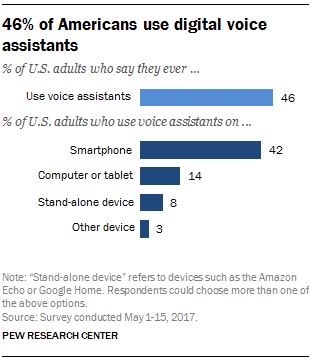Are voice assistants the future of email marketing?
Google Assistant was released two years ago. Microsoft Cortana and Amazon Alexa both came out in 2014. And Apple’s world-famous Siri was introduced to the world in 2011 (unless you count the original third-party app it was based on from 2010).
The world of voice assistants has been with us for the better part of a decade. With it is a world of punditry, criticism, and prognostications about what voice assistants mean for marketers in general and the email industry in particular. Back in December, Kevin Mandeville wrote about how Alexa reads emails (with tons of examples to listen to). More recently, Jenna Tiffany wrote about verbalizing emails on the Only Influencers blog, a post that’s spurred a lot of discussion in the industry.
Most in the industry seem bullish on the prospects of voice assistants and email. They’re excited about this young technology and the possibilities it could theoretically afford. Others cite privacy concerns and usability issues as downsides to catering to voice assistants in email marketing. All of these differing opinions have left us asking the question:
What do voice assistants mean for email marketers?
Current Capabilities are Limited
The first thing to consider is what voice assistants are currently capable of. As Kevin made evident in his excellent post, Amazon Alexa only has rudimentary email capabilities. Alexa can do one of five things with your email:
- Read it
- Reply to it
- Delete it
- Archive it
- Switch to the next message
This could be beneficial for email marketers as it does put messages in front of otherwise busy subscribers. For someone who’s engaged in some activity around the house, they can quickly check out their email messages, listen to specific ones, and reply when necessary. Apple’s Siri has had similar functionality since 2007. It’s an interesting new paradigm for interacting with email, but it leaves a lot to be desired.
For one thing, subscribers can’t complete more complex operations like subscribe or unsubscribe to emails, identify spam messages, or take advantage of interactivity in email campaigns. For marketers, the bigger issue is that there’s no real way for subscribers to convert via voice assistants. Since voice assistants don’t have a web browser built in, the path to conversion is stunted—leaving email marketers with little reason to cater to the voice assisted experience.
What’s more, tracking campaigns via voice assistants is (as far as we know) currently impossible. Email analytics hinge on users downloading a tracking pixel from a server. Since voice assistants are not, by definition, a visual medium, that pixel is never downloaded and marketers are left in the dark as to how many subscribers are using devices like Alexa to listen to emails.

What we can look at is overall voice assistant adoption. According to Pew, nearly half of American adults have used voice assistants, with the majority of usage occurring on smartphones. 55% of those users also said they use voice assistants to free up their hands. The same research showed that of those that don’t use voice assistants, 61% say they simply aren’t interested in the technology. That could be a troubling stat if it proves out to a wider audience.
A new article from Recode paints a more optimistic portrait. According to one cited study, 90.1 million US adults access voice assistants on smartphones every month. 77.1 million use voice assistants in their cars and 45.7 million rely on smart speakers like the Amazon Echo on a monthly basis. That’s a potentially huge pool of users that may start using voice assistants for email as the technology progresses.
There’s no doubt that voice assistant usage is on the rise and will be an increasingly important part of the technology landscape moving forward, but what’s the most likely use case for voice assistants and email?
Voice Assistants for Triage
In conversations at Litmus, we’ve generally agreed that voice assistants will likely be used for email triage, sorting emails for review at a later time and on a different device. I liken voice assistants to the modern day answering machine. Look at nearly any television show from the eighties or nineties and you’ll likely find a scene where someone listens to their messages and mashes the “next” button through robocalls and messages about upcoming appointments until they find what’s important, whether it’s a message from family, friends, or their current love interest.
With the current limited feature set, we expect voice assistants to provide virtually the same experience for the inbox. Usage will largely consist of subscribers sorting their messages, deleting the cruft, and following up with the important ones once their hands are free or they’re in front of a more capable device.
Still, there will be some users that will rely on voice assistants to consume the entirety of their inbox.
The Need for Accessibility
Disabled users are a huge population that need extra consideration when it comes to email. According to the US Census Bureau, nearly 1 in 5 people in the US have a disability. For those with visual and mobility impairments, voice assistants provide a much-needed way to access information otherwise unavailable to them. They are the people that will rely on tools like Siri (and Apple’s VoiceOver), Alexa, Cortana, and Google Assistant to not only triage but read and reply to emails.
This is where email marketers should be focused. As voice assistants read the HTML (and in some cases the plain-text) version of a campaign, we need to make sure that voice assistants can read our emails with as little confusion as possible. This is where email accessibility comes into play. As Jaina wrote back in 2017:
Email accessibility means making sure that everyone can receive and understand your message, regardless of any disabilities or assistive devices they may be using.
That extends beyond assistive technologies like screen reader software and into the world of voice assistants. Using some simple techniques, email marketers can create more accessible email campaigns that work better for everyone. In particular, we should all strive to:
- Use semantic HTML markup
- Create a strong content hierarchy with the most important information ahead of any social links, disclaimers, and other distractions
- Write more readable copy that the majority of people can easily comprehend
Perhaps most importantly, email marketers need to move beyond just image-based emails and embrace text-driven campaigns instead. As Kevin made evident, Alexa struggles with understanding accessibility-related markup like attributes, roles, and the all-important ALT attribute. If you’re using just images for emails—even with included ALT text—then voice assistant users won’t be able to consume or understand your message. Along with email clients that disable images by default, screen readers and voice assistants should be all you need to push back on image-based emails. In the words of email expert Elliot Ross:
It’s yet another reason why all-image emails suck. So don’t do them.
Should we worry?
Let’s go back to the original question posed in the title: Are voice assistants the future of email marketing? In my opinion, no. But will they be part of the future of email marketing? Yeah, of course. Heck, they already are to some extent but they’ll remain a very small part for the foreseeable future.
There are far more important things to focus on in email over buzzword topics like voice assistants.
How about making your emails accessible for disabled users? Or using diverse content to create more inclusive experiences for everyone? How about focusing on the fundamentals like proper segmentation or delivering the right message at the right time?
As email marketers, our job is to provide the most value we possibly can to our subscribers. We need to focus on that above all else, rather than chasing the latest technology that doesn’t have widespread usage. If that usage does become widespread, though, we need to account for it in our strategy. That’s just how the game of email (and marketing and technology) works.
So, stop reading all these articles on voice assistants and get back to the important work you need to do today. Look at your content calendar. Look at your subscriber lists. Look at what you can put on that first one to improve the second. We’ll be here to let you know when you should start to worry about Alexa and her ragtag group of friends.
What do you think?
What do you think voice assistants mean for email marketers? Join the discussion over on the Litmus Community.

Jason Rodriguez
Jason Rodriguez was the Community & Product Evangelist at Litmus
